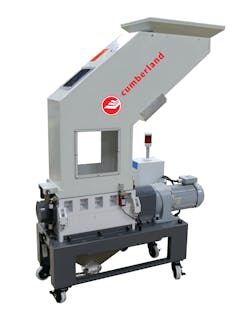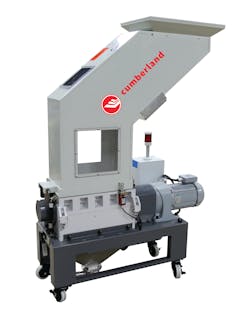Cumberland has introduced a new series of small, beside-the-press screenless granulators with a range of features that reduce energy consumption and noise while also improving operator safety.
Adams said the company has been able to reduce the horsepower demands of its new granulators while maintaining or increasing output compared with the earlier S series. “The more torque you need, the more horsepower you need, so if you can reduce the torque, you can generally get away with a smaller motor. … On the S series, the smaller cutters were all in line … whereas on [the S10 series], both the large cutters and the small cutters are staggered to give you that enhanced torque distribution and lower the power [demand].” So, while the largest granulators in the S series required a 3-horsepower (hp) motor, the largest models in the S10 series can achieve the same throughput with a 2-hp motor.
The S10 granulators are primarily for sprues and runners from injection molded parts or small pieces of extruded material, but Adams said they can also handle very small parts, such as deodorant caps.
Several factors, including the reduced horsepower requirement, combine to ensure that the machines create little noise or dust. Adams said the machines spin at roughly 25 rpm, compared to competitors’ screened beside-the-press units that might rotate at 250 rpm to as fast as 750 rpm. The staggered blades also produce uniformly sized regrind with minimal dust.
Cumberland, a division of ACS Group, also improved the S10 series by revamping the infeed chute, changing it from a straight vertical drop in the S series, to an angled drop. This serves two purposes — first, as material is fed into the granulator, it slides down the chute, where a powerful magnet captures metal contaminants before they meet the blades. The angled chute also contributes to the granulator’s quiet operation, because sound doesn’t have an easy path out of the chute.
Operator protection has also been improved, with the machines boasting three safety interlocks. “There were still two safety interlocks on the S series, but … there’s always ways for operators to outsmart the system,” Adams said. “So, we try to make it a little more bulletproof here, where there’s really no chance for an operator to drop the bin or open the chamber until that thing comes to a complete stop.”
There are also viewing windows on the hopper, which is new. “That gives you instantaneous feedback,” Adams said. “You can just look in the window to check and see how things are processing … without having to shut down and wait for the thing to stop spinning and open up the hopper.”
Adams said the 360-degree rotating vacuum takeoff is also a big improvement, making it easy to connect to the facility’s discharge system.
“Previously [with the S series], it was a fixed-vacuum takeoff, so you’d either have to accommodate by plumbing in flexible connections or rotating the machine 90 degrees if you needed to change that. Whereas now, it’s just one clamp that you loosen up and you can rotate the vacuum takeoff to any direction you want without physically moving the machine.”
The company said the granulators have a small footprint and offer easy access for maintenance and quick cleanup, which speeds material changeovers.
David Tillett, copy editor
Contact: Cumberland New Berlin, Wis., 262-641-8600
About the Author
David Tillett
Associate Editor David Tillett writes and edits for Plastics Machinery & Manufacturing, Plastics Recycling and The Journal of Blow Molding. He covers new products, industry news, patents and consumer and business equipment. He has more than 20 years of experience in daily newspaper, online and magazine journalism.

